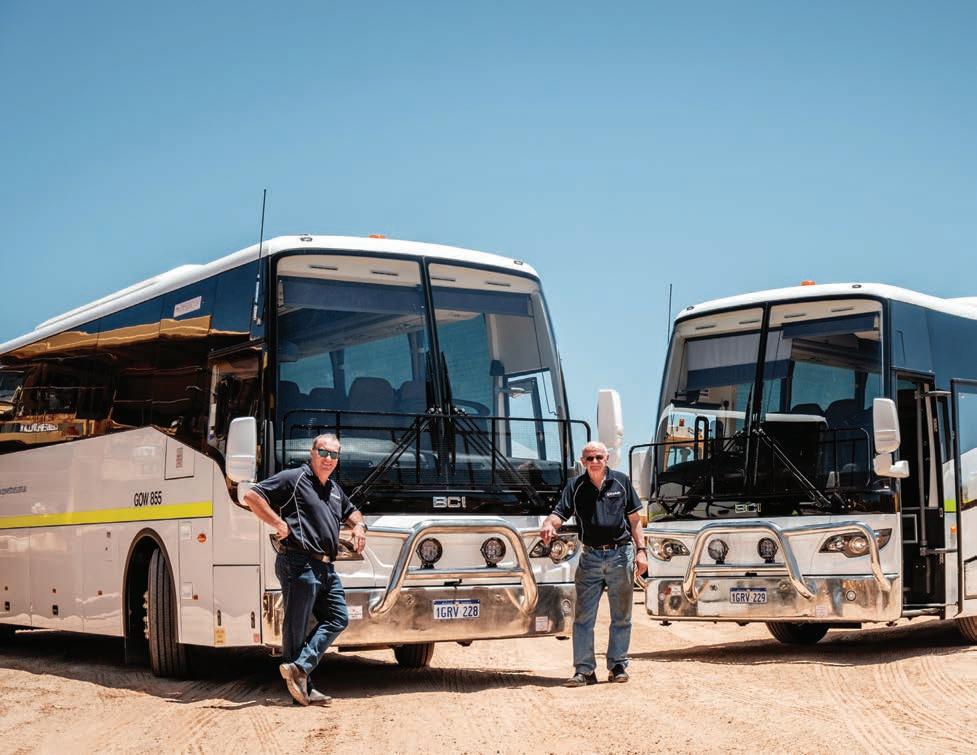
29 minute read
news | the front line
SEALINK BUYS WA BUS OPERATOR GO WEST
BUNBURY, Western Australia- based integrated transport provider Go West – established and run by venerable bus industry family the Haousts – has “agreed to a deal with potential consideration in excess of $100 million” in its sale to the Sealink Travel Group.
Go West, with lead adviser BDO, negotiated the sale of the successful, home-grown Australian bus operator best known for bus and coach transport, particularly in the mining resources field.
The operator began in 1981 with a single bus and grew to become one of Western Australia’s pre-eminent specialty providers of charter, rental and tour vehicles to the resources and public transit sectors, filling more than 500,000 seats monthly, BDO explains.
Go West’s expansion is the result of its clever uptake of cutting-edge technology – including innovative fatigue management and asset monitoring
systems – and rigorous focus on top-tier resource client service throughout the years, BDO adds.
Forging close ties to the booming Western Australian resources market, Go West’s established regional infrastructure in key mining hubs – including Port Hedland, Newman and Karratha – made the family-owned company an attractive prospect for Sealink Travel Group, complementing its portfolio of world-class transit providers, BDO states.
CONTINUED GROWTH
“With the support of Sealink, Go West will continue to grow well into the future,” said Go West founder and director Stan Haoust.
“As fellow operators supporting
Above:
“With the support of Sealink, Go West will continue to grow well into the future,” said Go West founder and director Stan Haoust. the resources sector, Sealink will enable Go West to continue to tackle bigger projects and, importantly, Sealink aligns with Go West’s ethos, which is ‘family spirit’, ‘frugality’, ‘adaptiveness’, ‘innovation’ and ‘safety’,” Haoust explained.
Sealink is Australia’s largest integrated transport provider, moving more than 206 million customers per year, it states. Its holdings include Captain Cook Cruises, Sealink Rottnest Ferries and Swan Transit – largely responsible for Perth’s urban bus network.
The acquisition – valued at 5.3x normalised LTM EBITDA, confirms BDO – will see the existing management team retained,
including director David Haoust.
“Go West has valuable contract counterparties and delivers an essential service for these clients,” said Sealink Group chief executive offi cer Clint Feuerherdt.
“The operations of Go West were unaffected by the pandemic and continued at near 100 per cent levels throughout, keeping their communities and worksites connected,” he added.
THE ADVISERS
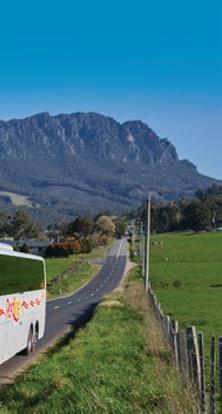
BDO’s Perth mergers and acquisitions team advised Go West on all aspects of the transaction, while Sealink was advised by Gresham in Sydney. BDO predicts more mining services deals to come, it says.
“Australia’s buoyant economy and strong industry growth will see signifi cant interest and further sales of Western Australian mining services businesses to local and international buyers,” said Todd Grover, lead BDO partner on the transaction.
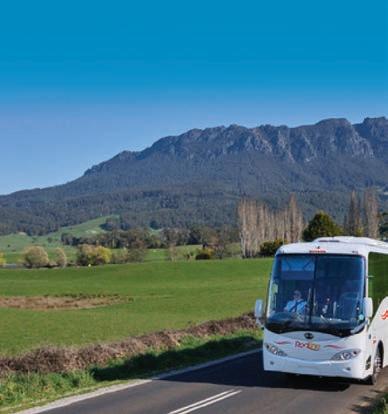
KINETIC ACQUIRES OPERATOR TASMANIAN REDLINE
SKYBUS’ PARENT company Kinetic, with a focus on the Apple Isle, has acquired long-standing family run bus operator Tasmanian Redline.
Tasmanian Redline Coaches (Tasmanian Redline), the largest governmentcontracted private bus operator in Tasmania, will join Kinetic’s growing bus mass transit network as it boosts its commitment to investing in the island state, the company states.
Tasmanian Redline is one of the state’s largest busing operators, providing government-contracted route and school services across Burnie, Devonport, Hobart, Launceston and Smithton, as well as charter services for major tour operators, Kinetic confi rms.
The company is one of the state’s most established bus brands, having proudly operated for more than 90 years.
Last year, Tasmanian Redline launched a new premium coach transfer service, the Redline Express, connecting travellers from Hobart and Launceston directly with the Spirit of Tasmania in Devonport, Kinetic states.
Collectively, Kinetic’s mass transit platform currently encompasses more than 52 government-contracted urban, regional and school bus services and private charter services in key cities and regional centres across Australia and New Zealand, it confi rms.
JOINT OPPORTUNITIES
Tasmanian Redline managing director Michael Larissey says he was excited to have the support of a fast-moving and innovative mass transit team in delivering on the transport needs of Tasmania.
“We are a proud Tasmanian business with a deep-rooted history working with the government and other important stakeholders to connect people with where they need to go, and Kinetic has a strong alignment with our vision and we are really excited by the joint opportunities ahead,” Larissey said.
EXCITED WELCOME
Kinetic head of Australia, Matthew Carney, says Kinetic was excited to welcome Tasmanian Redline to its growing mass transit platform.
“Tasmanian Redline has unrivalled experience as one of the state’s preeminent transport operators and I congratulate the Larissey family and their team for their long-time commitment to supporting the state government and serving the community,” Carney said.
“Buses are an important component of Tasmania’s public transport network and tourism industry and, as the major economic precincts of Launceston and Hobart continue to grow, people will have an increasing need for regular and reliable bus services that get them to where they want to go.
“Through our Skybus operation we have enjoyed strong relationships with Hobart Airport and the Tasmanian government, and we’re excited to continue supporting our stakeholders to enhance existing bus networks while identifying opportunities to introduce innovative and sustainable transport solutions for Tasmanians and visitors alike,” he added.
TRANSIT SYSTEMS ORDERS OZ’S FIRST HYDROGEN CITY BUSES
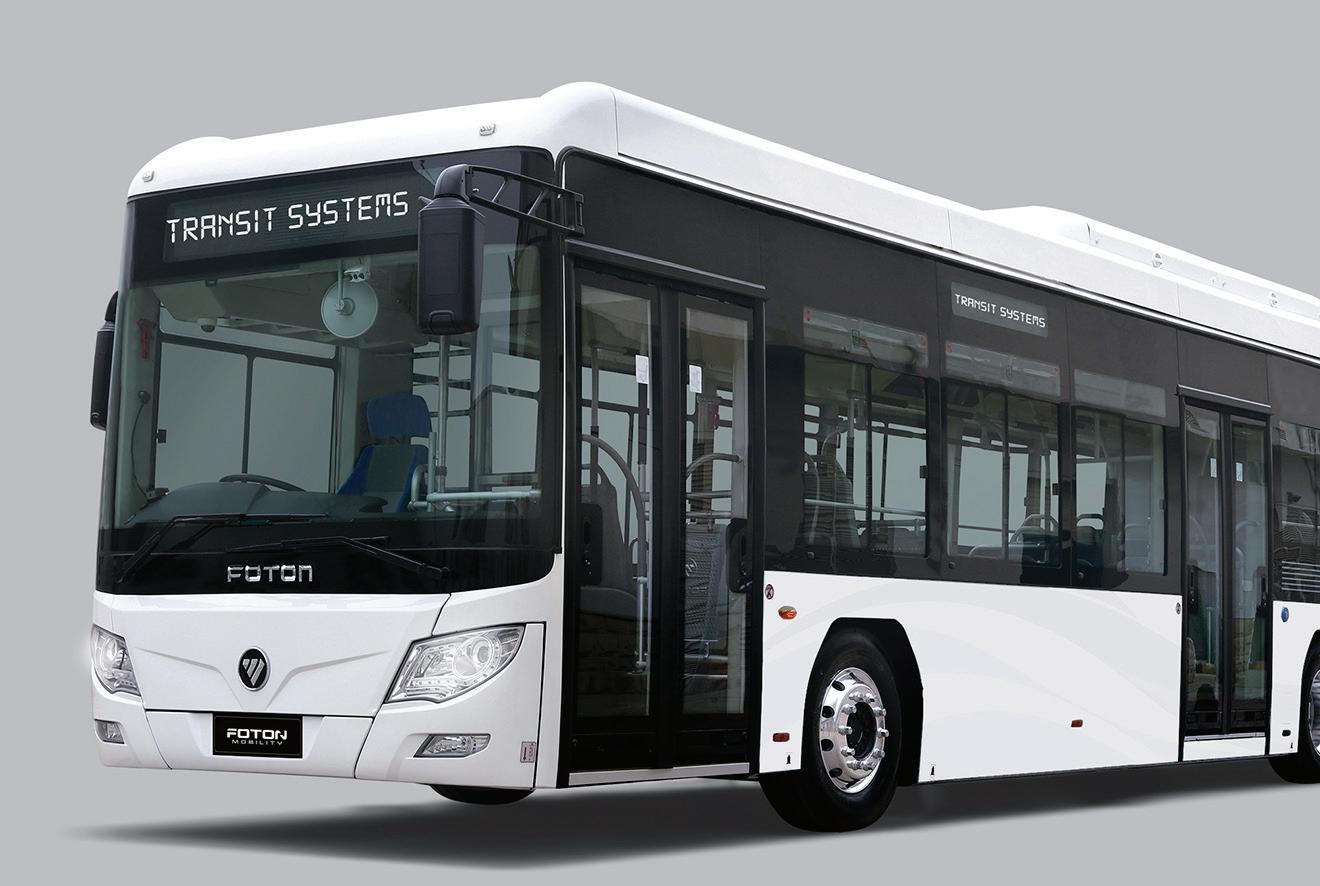
BUS OPERATOR TRANSIT SYSTEMS has purchased the first hydrogen fuel-cell buses to service public transport contracts in Australia, the company has announced.
Sealink Travel Group CEO Clint Feuerherdt says the two innovative buses – Foton hydrogen fuel-cell vehicles – would likely go into service by mid-year, with sources telling ABC magazine that their NSW, Victoria, SA or WA operation are to be confirmed.
“We are proudly setting the global benchmark for exploring and trialling different technologies to find and develop solutions with our key industry partners that suit the dynamic and complex operating conditions within
ADL E-BUSES FOR TRANSDEV’S HOWICK & EASTERN
NEW ZEALAND bus operator Howick & Eastern, part of Transdev Australasia since late 2019, has ordered two ADL-BYD 12.6-metre e-buses from Kiwi Bus Builders bodies, ADL announced recently.
To be used on Auckland Transport (AT) services, the three-axle single-deck ADL-BYD Enviro200EV XLB buses are being built for the specific requirements of bus operation in New Zealand, allowing it to carry 78 passengers without requiring an overweight permit, ADL explains.
It uses the latest BYD iron-phosphate battery and driveline technology, with dual AC and DC plug charging adding operational flexibility, it adds.
New Zealand is preparing to fully transition its bus fleet to zero-emission vehicles by 2035 as part of a wider set of measures intended to help meet the country’s 2050 carbon neutral target.
Howick & Eastern by Transdev general manager Sheryll Otway said: “The future for zero-emission transport in New Zealand is exciting and Howick & Eastern by Transdev is proud to be an ongoing part of this incredible journey, with the commissioning of these buses.
“None of this would be possible without the support, vision and investment of Auckland Transport.
“We are certainly looking forward to working together over the coming years as we work together on providing zero-emissions public transport to the people of Tāmaki Makaurau.”
LOCAL JOBS
Transdev New Zealand managing director Greg Pollock said: “Howick & Eastern by Transdev opted to commission ADL to build our second and third electric buses because the company’s factory is in New Zealand. This was a logical decision for us to make, given Transdev’s commitment to New Zealand and to expanding our operations here, where we already operate metro rail and bus services in both Auckland and Wellington, as well as a transport on demand trial in Auckland,” he explained.
Above:
Of the Foton hydrogen buses, Feuerherdt says both drivers and passengers reported positive experiences. the Australian public transport landscape,” he said.
Transit Systems, which is part of the Sealink Travel group, is dedicated to exploring innovative technologies, with a proud history of running the second-longest hydrogen bus trial in the world, as part of its Transport for London (TfL) operations, it explains.
Feuerherdt says the company was committed to exploring a range of products in the Zero Emissions Bus (ZEB) deployment.
“We don’t just have a willingness to adapt, but a desire to lead – and we’re proud to deliver innovative solutions to Australian streets and beyond, which broadcast a range of benefits into manufacturing and other industries,” he said.
“We are procuring and delivering these buses with the expectation and knowledge that future buses will be built here, with our partners at Foton Mobility, part of the Australian-owned True Green Mobility Group,” he added.
DRIVING FORWARD
True Green Mobility Group CEO Luke Todd commended Transit Systems on its vision to work with government partners and deliver sustainable solutions to the market.
“Transit Systems has delivered another first to the Australian public transport sector, and we’re incredibly proud to partner with them and drive innovation and sustainability forward,” Todd stated.
Todd says Foton has more than 700 hydrogen buses manufactured and deployed around the world, leading the way globally with hydrogen-powered buses, and the company was excited to see hydrogen buses on the road in Australia.
“Being leaders in hydrogen development, the buses that will be deployed in Australia are of the highest quality with best-in-class Toyota fuel cells. The buses are extremely quiet, with zero tailpipe emissions,” he said.
Todd adds that they expected to have mass production
underway in Australia by early 2022, with the orders being taken now.
POSITIVE EXPERIENCES
Feuerherdt says that both drivers and passengers reported positive experiences with a high level of comfort, as well as extended range capabilities compared to some battery electric options.
“We’re not just proud to bring hydrogen technology to Australia, we’re pleased to add it to our suite of products that demonstrate our understanding, expertise and commitment to a more sustainable public transport solution that suits each network partner and the local operating conditions across the globe,” he said.
Transit Systems currently operates metropolitan bus contracts in Victoria, South Australia, New South Wales, Western Australia and the Northern Territory, it confirms.
Kiwi Bus Builders managing director Richard Drummond said: “Howick & Eastern’s order underlines our plans to support up to 100 local jobs with the assembly of electric buses in partnership with ADL, as we scale-up our production to meet demand from Auckland Transport and elsewhere in New Zealand as the transformation to a zero-emissions fleet gets under way.”
New Flyer Industries (NFI)-owned Alexander Dennis Limited (ADL) general manager for NZ Tony Moore said: “We are delighted to extend our successful relationship with Howick & Eastern to clean electric buses, which have been tailored to the requirements of bus operation in this country. This would not have been possible without the close collaboration with Kiwi Bus Builders, as well as with the team at BYD Australia.”
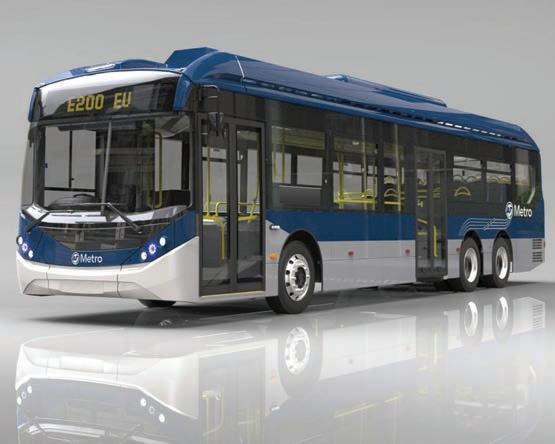
TRANSDEV CELEBRATES INCLUSION COMMITMENT VIA ‘PRIDE’ E-BUS
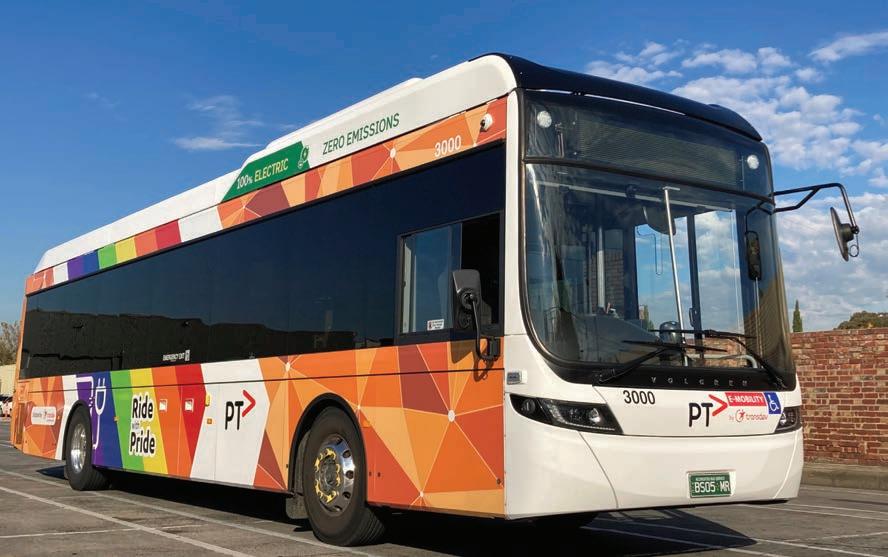
TRANDEV MELBOURNE has unveiled a Pride-themed rainbow bus to demonstrate its commitment to connecting and supporting Melbourne’s diverse communities.
Victoria’s first fully electric bus featured the special Pride-themed livery throughout May and appeared at the Midsumma Festival Pride March on Sunday, May 23, together with Transdev Melbourne employees, the company confirms.
Transdev Melbourne managing director Ian Craig said: “We are committed to delivering an inclusive, welcoming and safe bus service for all.
“At Transdev, inclusion is more than just a word, it is about respecting and appreciating people for who they are.
“We hope this bus sends a clear message to our customers, the community and our people about the value we place on diversity,” he added.
RAINBOW SIX 3
The special livery encourages members of the lesbian, gay, bisexual, transgender, queer and intersex (LGBTQI+) community to ‘Ride with Pride’, a slogan developed by Transdev staff in 2019 to show support for members of the LGBTQI+ community and demonstrate Transdev’s commitment to diversity, the company explains.
LGBTQI+ Transdev staff and allies participated in the annual march, which celebrates solidarity in gender and sexuality diversity in front of more than 45,000 people, it explains.
Earlier this year, Transdev’s Sydney light rail featured rainbow livery to coincide with Sydney’s annual Mardi Gras festival.
ABOUT TRANSDEV
Transdev believes public transport plays an important part in how a city comes to life, it states. Its day-to-day work influences families, friends and future generations where they live, work and play, it adds.
In Australasia, Transdev has 5,704 people passionate about operating its 2,150 vehicles and vessels, which deliver more than 145 million customer journeys each year, it explains.
Above:
“At Transdev, inclusion is more than just a word, it is about respecting and appreciating people for who they are,” said Transdev Melbourne managing director Ian Craig.

SYDNEY BUS INVOLVED IN FATAL CAR COLLISION
A WOMAN died after a car and bus collided in Parramatta, NSW on the morning of May 1.
Officers from Parramatta Police Area Command were called to Argyle Street, near the intersection with O’Connell Street, shortly after 8.00am, after the BMW and bus collided.
The front-seat passenger in the sedan, a 46-year-old woman, was unable to be freed from the wreckage and died at the scene, police confirm.
The 54-year-old driver of the sedan and the 66-year-old bus driver were taken to nearby Westmead Hospital with minor injuries and for mandatory testing, police state.
There were no passengers on the bus at the time, the police add. The area was closed while utility workers repaired damage to power lines caused by the crash.
The BMW driver has now been charged with dangerous driving and negligent driving, both occasioning death, and driving through a red traffic light. He has had his driver’s licence suspended and been granted conditional bail, with a court date at Parramatta Local Court set for Wednesday, June 9.
Police have appealed for witnesses with dashcam footage of the incident to come forward.




REAL-TIME EMERGENCY INFO FOR BUS OPERATOR SUCCESS
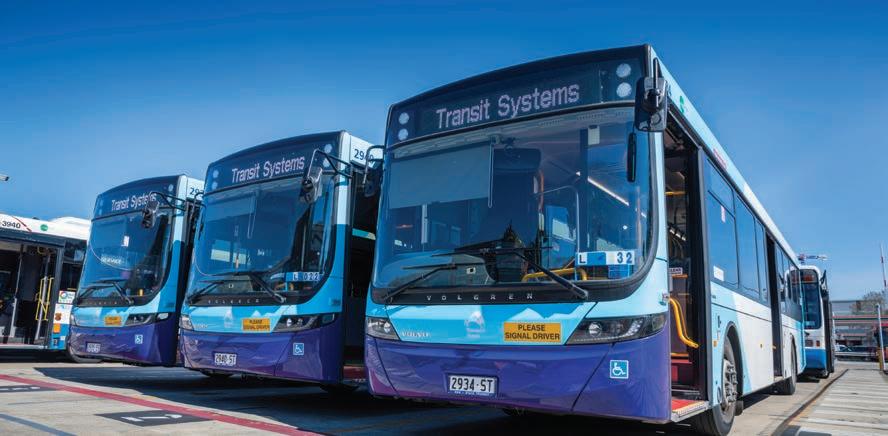
BUS OPERATOR Transit Systems has ensured timetable and crisis information, such as bushfire reports or health emergencies, is instantly disseminated across its national network – an Australian first for a bus operator, the company reports.
Transit systems has ensured such information reaches its huge employee base via the ‘Blink’ system – a globally recognised platform, “…for secure, private and formal engagement with employees, but offers more than real-time access to policy and procedure documents.”
To put this into context, particularly from a regional perspective, it’s remarkable because, considering it has more than 2,600 buses on the road across Australia, and 85 per cent of its workforce is ‘deskless’, employees may need to get an update, or receive important information based on location, shift or role [instantly], according to SeaLink Travel Group CEO Clint Feuerherdt.
“We were in the process of rolling out the Blink communication system prior to Covid-19, but it was an incredibly beneficial time to have it as a resource, and remains so critical to our continued operational safety,” he said.
“The essentials are all there, but what’s been truly impressive is the uptake by our team and the engagement we have seen on the platform.
“Particularly in regard to Covid-19, we’ve been able to push out real-time alerts in hot-spot areas and make our team aware of health agency directives, which has meant we have significantly reduced the risk of employees going to work and potentially spreading the virus.”
INTER-EMPLOYEE COMMS
Team members can also chat with colleagues by posting on the feed, or connecting with other individuals across the business.
“The platform has been invaluable in connecting regional and remote teams - for education, support, learning and laughter; there’s a huge sense of camaraderie on the chats.
Blink can be used on a phone app, or via the website, and Feuerherdt says it was another element of innovation within the SeaLink Travel Group.
“We are investing heavily, not just in technology around zero-emission networks, with electric bus trials underway, the operation of hybrid vehicles and research into hydrogen capabilities, but also into technology that supports our team to best service the communities we operate in,” he said.
Nearly 100 per cent of employees across the business actively use their account, with more than 20,000 comments and messages sent in NSW since the platform launched in 2020, while Rivercity Ferries in Queensland has in excess of 2,000 messages and comments since being established late 2020.
Swan and Torrens Transit have 100 per cent active users, with Torrens Transit achieving nearly 1,500 comments and messages. Transit Systems Victoria already has more than 250 comments and messages since it was launched.
Below:
Blink can be used on a phone app, or via the website, and Feuerherdt says it was another element of innovation within the SeaLink Travel Group. ABOUT SEALINK
SeaLink Travel Group is Australia’s largest integrated land and marine, tourism and public transport service provider with established international operations in London and Singapore, it confirms.
It is one of Australia’s most experienced and diverse multi-modal transport businesses.
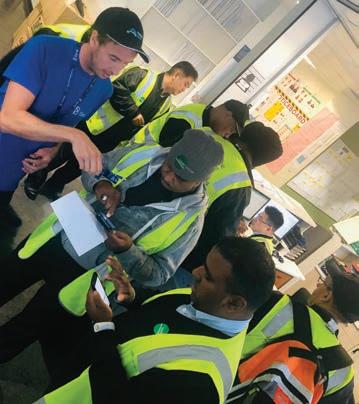


VOLGREN PERTH LYNCHPIN ENJOYS BOTH BUS AND MUSIC WORLDS

IN A CAREER spanning 20 years, a Volgren Perth employee went from bus spray painter to production manager while managing to moonlight as a musician in a range of coverbands – including a John Farnham tribute band.
After John Pettit left school he undertook an apprenticeship as a painter decorator, but spent little time during the next decade plying that trade. Instead, he pursued a musical career that started in his home state of Western Australia and brought him to New South Wales playing piano and keyboard for coverbands and other groups throughout Sydney, he says.
“It was a good life,” Pettit recalled. “There were plenty of gigs and Sydney was a great place to be a musician – but there was limited job security.”
That lack of guaranteed work, in combination with a desire to own his own home, led Pettit back to WA in the late 1990s, where he found a job as a spray painter at the WA government Railways, he explains.
In 1999, Volgren became prime contractor for the Public Transport Authority (PTA) and established a major facility in Perth. It was a moment that would change the course of Pettit’s professional life, he says.
“When Volgren set up I was working at Osborne Motor Bodies and they were actively headhunting from a number of local manufacturers and I jumped on board in January 2000, as a spray painter.”
Pettit says the fi rst vehicle he worked on was Bus 38 and he did so with four colleagues in what was known as ‘the paint shop’. Within six months he’d been promoted to the position of team leader and was running the shop.
Since moving into a leadership role – he’s been promoted several times since – he has felt the natural pressure that comes with being a central part of one of Australia’s most successful and long-standing bus supply agreements, he says. Pettit deals with that pressure, he says, by concentrating on his main strength.
“My biggest asset is communication. I don’t have a fabrication or engineering background, so I need to be constantly connecting with people, keeping people motivated and working through any problems,” Pettit stated.
“It’s all about knowing the right people that can do the job for you.”
This goes a good way to explaining how Petitt has become such a vital member of the Volgren team, good people-management skills only get you so far, he says; in a job such as his, results matter more than anything, he explains.
“We understand the quality and standard that PTA require and we bend over backwards to make it happen. We’ve never missed a month of deliveries – ever.
“We’ve been dealing with the PTA for more than 20 years. We enjoy a great working relationship. The rapport between the two organisations couldn’t be any better; it’s built on respect and honesty,” he said.
“If something’s not right, we understand the issue and it’s fi xed immediately.”

THE WOT!?!
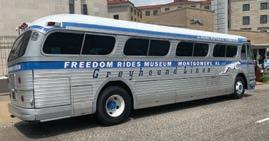
FREEDOM RIDE
A restored vintage Greyhound bus has been unveiled to commemorate the 60th anniversary of the Freedom Rides – a series of political protests against racial segregation in 1961. Housed at the Alabama Historical Commission’s Freedom Rides Museum in Montgomery, itself located at the Greyhound bus station the Freedom Riders arrived at, this bus was in service when civil rights activists participated in bus rides in southern USA to protest segregation in transport facilities. “History happened here,” said Lisa D. Jones, executive director of the historical commission and the state historic preservation offi cer, at the ceremony. “Preserving this place helps bring to life a critical part of the civil rights story, and the role Montgomery and the state of Alabama played in it.”

EASY RIDER
Have you managed to sit yourself down behind the wheel of a Mercedes-Benz eCitaro yet? If not, you just need to hang on until September when Bus Simulator 21 is released to bus-hungry gamers. Among the 30 offi cially licenced buses available in this transport simulator will be two new eCitaros: the small two-doored, 12-metre electric with two axles, and the larger threedoor, 18-metre, three-axle eCitaro G articulated. Other bus brands include Setra, Iveco Bus, Alexander Dennis, BYD, Grande West, Blue Bird and more. Game on!

SPACE RACE
Southeastern Pennsylvania Transportation Authority (SEPTA) in the US has launched a new website tool to help bus passengers estimate when their service will be less crowded. Named the Estimated Seat Availability Dashboard, the majority of SEPTA’s bus routes have been mapped with a colour-coded system so customers can look up the time they want to travel and the specifi c stop they get on at to see how busy the bus usually is and whether they are likely to get a seat. The feature will be expanded to include other transport services and integrated into SEPTA’s offi cial app later this year. To check it out, visit: https://septa.org/ seat-availability
VICTORIAN REGIONAL ROAD UPGRADE AIDS V/LINE COACH ROUTES
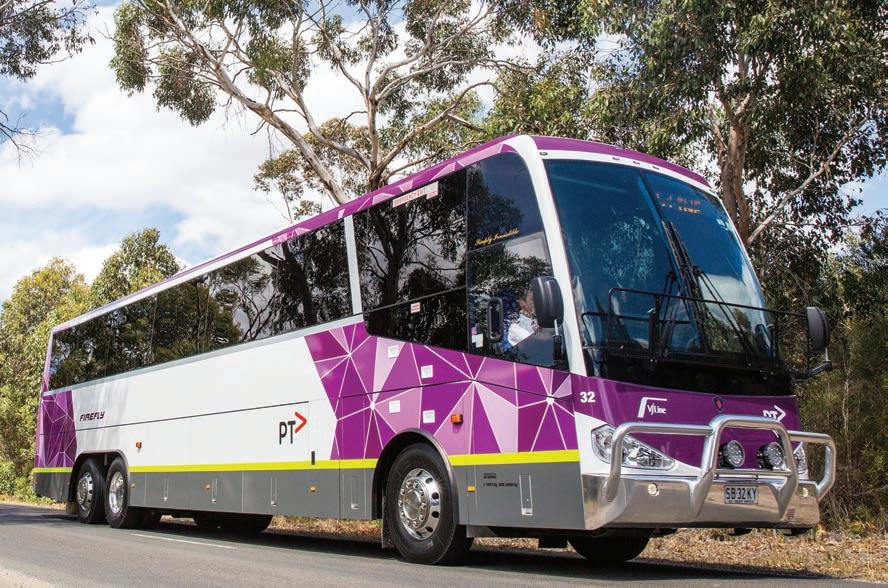
RURAL VICTORIA dairy farming town Tinamba is now a safer place to drive to and through for V/Line coach services following completion of a road overhaul via the Flexible Local Transport Solutions program, the state government reports.
Minister for roads and road safety Ben Carroll says the $150,000 upgrade had delivered a number of benefits for the local community.
The project will improve access to V/Line coach services (south-west) to Traralgon and (south-east) to Sale from Tinamba, providing stronger links to employment and education opportunities for locals, and connections to train services on the Gippsland line, according to the government.
Works have also improved pedestrian and vehicle access to local businesses, improved kerbs, line-marking, drainage and bus stops – including a new stop on the western side of the road and upgrades to the existing stop on the eastern side, it adds.
The Labor government has invested $40,000 from the Flexible Local Transport Solutions program and a further $90,000 from its Building Works program, delivering improvements on Traralgon-Maffra Road through the town, it explains. Wellington Shire Council also contributed a further $20,000 to the upgrades, it confirms.
The Flexible Local Transport Solutions program provides funding for local transport
initiatives, services, and infrastructure in regional Victoria. The program works with local transport forums, regional partnerships, local councils, and community organisations to identify and deliver these opportunities.
SAFER ACCESS
“We’ve worked with Wellington Shire Council and local businesses to deliver this upgrade that has not only provided safer access for pedestrians and vehicles in Tinamba, but also improved the overall amenity of the town,” said Carroll.
“This project has made the town centre a more attractive stopping point for passing tourists whilst also helping improve vital public transport links
to employment and education opportunities for locals.”
Member for Eastern Victoria Jane Garrett said: “It is wonderful to see the positive impact this project has already had on Tinamba with improved parking upon entry into the town.”
“For locals and business owners, these improvements contribute to the town’s viability and enhance the safety for all road users,” she stated.
SIEMENS AND YHI PARTNER IN NZ
EUROPEAN global technology powerhouse Siemens has partnered with YHI Energy in New Zealand to support the country’s growing electric-charging market and launch its latest EV charging-infrastructure portfolio, the companies announced recently.
The partnership will see YHI Energy – one of New Zealand’s leading suppliers of energy products, especially in electric vehicle charging infrastructure – distribute Siemens’ state-of-the-art charging infrastructure portfolio, they confi rm.
This agreement complements Siemens’ partnership with Cuthbert Stewart Limited (CSL), which distributes Siemens factory automation, process industry, electrical and drives products in New Zealand, Siemens clarifi es. The YHI announcement also follows recent customer wins, such as the agreement to supply e-bus charging infrastructure to Go Bus, one of New Zealand’s largest bus operators.
Siemens New Zealand CEO Paul Ravlich welcomed the partnership stating: “Electrifi cation of our transportation fl eet plays a signifi cant role in the decarbonisation of New Zealand. To achieve this, we need the right infrastructure in place, so the access to the best-in-class technology is more accessible.”
According to the companies, YHI Energy will distribute three key products from Siemens’ portfolio: • Versicharge AC Smart Wallbox (7.2kW-22kW): a fully featured, space-effi cient wallbox inclusive of smart connectivity and load management options as standard • Sicharge CC AC22 dual-port pedestal (22kW): an attractive and robust charger with unique branding options • Sicharge D high power DC charger (160kW-300kW): an innovative DC charger enabling modular power upgrades, dynamic power allocation and up to fi ve vehicles charged in parallel.
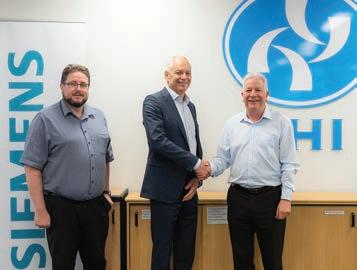
Above (L-R):
Aaron Gillon, divisional manager, YHI Energy; Paul Ravlich, CEO Siemens New Zealand; and Chris Talbot, managing director YHI Energy.



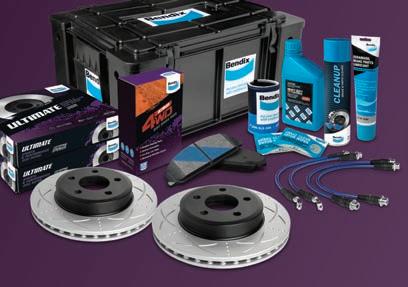
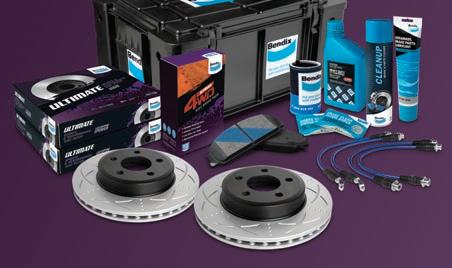
The Bendix Ultimate 4WD Brake Upgrade Kit with advanced brake pads and rotors, braided lines and a host of ancillary items is the ultimate brake upgrade for the latest 4WD vehicles such as Ranger and Hilux.
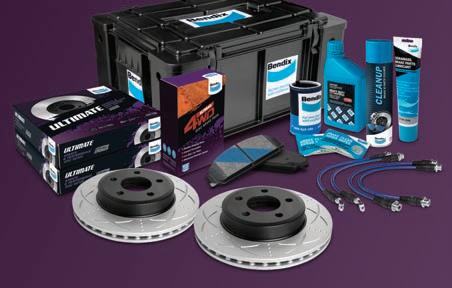



This comprehensive kit includes specially compounded high performance CERAMIC material brake pads for increased stopping power in extreme material brake pads for increased stopping power in extreme conditions plus the latest Bendix Ultimate Rotors designed and designed and developed specifically for Australia’s demanding conditions.
Find solutions for every brake job at www.bendix.com.au
Or freecall the Bendix Brake Advice Centre on 1800 819 666
Bendix is a trademark of Garrett Advancing Motion Inc.
LANDMARK HYDROGEN-DIESEL BUS EMISSIONS TRIAL
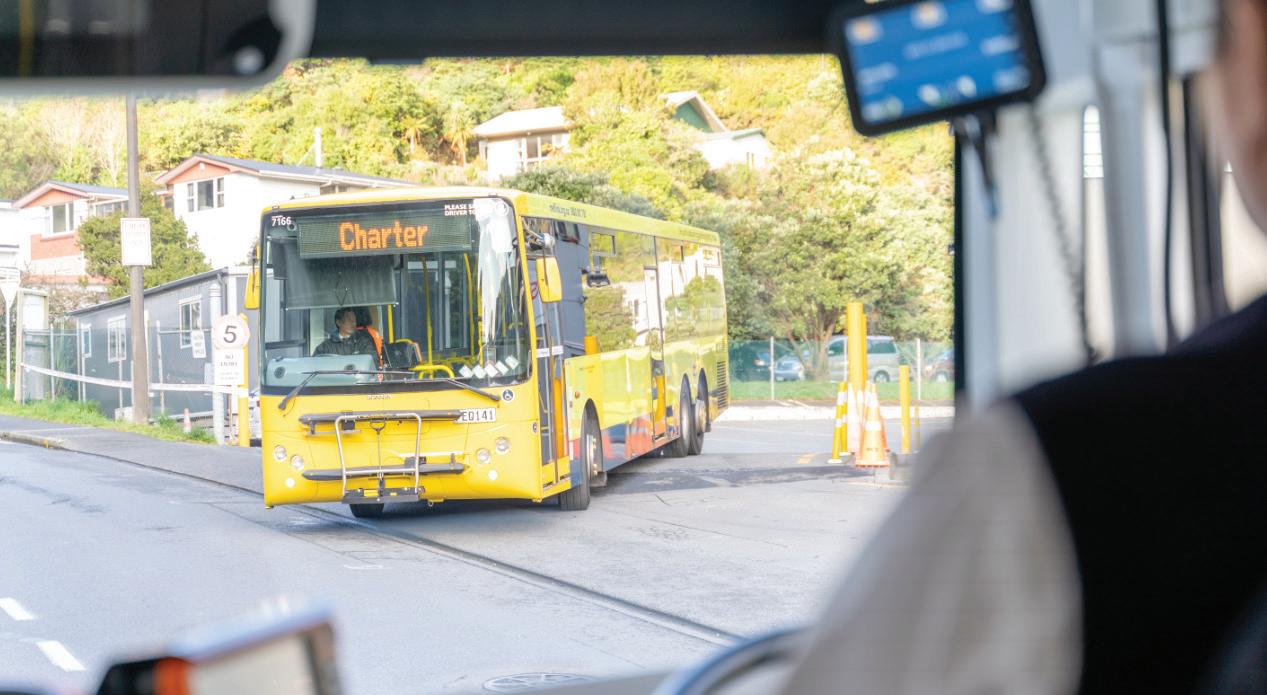
IN WHAT COULD PROVE the crucible in which diesel bus fl eet emissions and vehicle composition are determined in future worldwide, a radical Australasian-led trial of hydrogen injected into conventional fuel could prove an unexpected turning point in the commercial vehicle industry.
In efforts to reduce its carbon footprint, Transdev Australasia – operator of Howick & Eastern Buses in Auckland and Mana Newlands Coach Services in Wellington – has committed to trial a new hydrogen fuel technology in its existing diesel bus fl eet.
Transdev New Zealand chief offi cer and managing director Greg Pollock says trials would soon commence using the new ‘HYDI hydrogen fuel system’, which has been designed to fi t a standard diesel bus, adding hydrogen gas to a diesel engine.
“A HYDI hydrogen unit will soon be fi tted to buses in our Wellington fl eet, with the goal of testing to determine what level of reduced fuel consumption and ensuing emissions we can achieve in Wellington conditions,” Pollock said.
“Globally, transport accounts for more than 24 per cent of total CO2 emissions yearly, which is why we are exploring more electric and hydrogen fuel technologies to reduce our environmental impact and meet New Zealand government’s emissions reduction targets.”
South Australian company HYDI Hydrogen has developed the technology, Transdev confi rms. HYDI’s website, states its hydrogen direct injection system provides, ‘lower emissions and more power from less fuel.”
UNIVERSITY TESTING
HYDI managing director John Wilson says independent testing of the HYDI Hydrogen ‘on-demand’ system at the University of South Australia had shown a reduction of up to 80 per cent in carbon particulate emissions when fi tted to a diesel engine.
If this real-world trial replicates results being achieved with heavy transport in Australia, this could change or determine bus and truck operator fl eet-buying trends in the immediate-to-long-term future, saving them millions in effectively ‘enforced’ new EV product purchases while ‘buying time’ for those very electro-mobility avenues of technology to be refi ned and enhanced, it could be argued.
SIGNIFICANT REDUCTIONS
“Analysis of the exhaust gas of a public transport bus fi tted with the HYDI Hydrogen system showed signifi cant reductions in greenhouse gases, including carbon,” Wilson said.
Over a period of fi ve months of normal operations in metropolitan Adelaide, the bus returned a 12.5 per cent reduction in fuel consumption. HYDI enables carbon emissions to be achieved immediately with a technology that pays for itself via savings in fuel usage, according to the company.
“While there is much attention on future fl eet technologies, there is usually substantial investment and long lead times required in delivering new fl eet[s], remembering that heavy vehicles, such as buses, have a life cycle of 20 years or more,” he said.
Transdev will trial the HYDI Hydrogen system in its bus operations locally in Wellington before assessing the suitability for other sites, it explained.
HOW IT WORKS
When ABC magazine sought further information as regards the actual process behind the system, HYDI CEO Roger van der Lee clarifi ed: “The technology exploits the well-known and proven electrolysis process to split hydrogen and oxygen molecules from water. This requires an electrical input, provided from the host engine’s battery and a minimal amount of distilled water.
“Hydrogen is only produced while the motor is running as an on demand system and introduced into the air intake of the engine.
“There is no hydrogen under pressure or storage thereby making the retrofi t system completely safe.
“The compact size, absence of chemicals, minimal electrical input and sophisticated electronics and fi rmware, which enables its integration with OEM engine management systems, make HYDI unique,” he explained.
GREYHOUND BUSES CLOSES PERMANENTLY IN CANADA
EFFECTIVE MAY 13, 2021, Greyhound made the difficult decision to close all its services in Canada, following “sustained ridership declines in Ontario and Quebec”, the company announced.
With media reports the move will cost about 400 employees their jobs, the company says
Greyhound Lines, Inc. (USA), a separate entity, will continue to operate cross-border express services on the following routes when the border reopens: Toronto to New York – Toronto to Buffalo – Montreal to New York – Montreal to Boston – Vancouver to Seattle.
“We deeply regret the impact this has on our staff and our customers, as well as the communities we have had the privilege of serving for many years,” Greyhound Canada senior vice president Stuart Kendrick stated.
“A full year without revenue has unfortunately made it impossible to continue operations.”
Greyhound Canada implemented a range of cost-reduction steps during recent years, including frequency adjustments to route schedules and other efficiency measures, it states.
In 2018, after years of declining ridership and the impact of a changing and increasingly challenging transportation environment, including de-regulation and subsidised competition – such as VIA Rail and publicly-owned bus systems – the difficult decision was made to suspend service in the western part of Canada. Services continued in Ontario and Quebec, it says.
The pandemic brought a further dramatic drop of approximately 95 per cent of normal volumes before operations were fully suspended in May 2020, the bus operator confirms.
Greyhound Canada has made significant outreach efforts to provincial and federal governments for financial support for the industry, it adds. Financial investments from governments for Canada’s inter-city bus sector have been negligible, it stated and operations are not feasible absent of financial support.
Customers holding tickets originating in Ontario or Quebec for travel within Canada after May 13, 2021, may request a refund. Also customers with non-expired Canadian travel vouchers may request a refund of unused travel voucher funds, Greyhound Canada states.
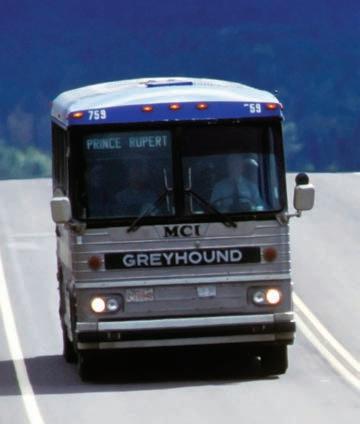
Above:
Greyhound has now stopped all services in Canada.
MCI LAUNCHES E-COACH DUO FOR NORTH AMERICA
TWO NEXT-GEN battery-electric coaches now bolster NFI Group subsidiary MCI’s e-bus range, with the D45 CRT LE Charge and J4500 Charge models launched for the North American market.
In unveiling its new zero-emission commuter coach, the D45 CRT LE Charge – also with innovative and functional low-entry vestibule ‘Harge’ – comes at a time the company also launched its new D series of coaches.
Leveraging high-torque electric drive systems for operation at highway speeds and plug-in battery charging – to fully in less than three hours – the battery-electric D45 CRT LE Charge “builds on MCI’s legacy of reliable mobility and harnesses three major innovations”, MCI states.
It exhibits design advancements of the next generation D series; introduces MCI’s innovative low-entry vestibule and integrates proven ‘Charge’ technology propulsion from New Flyer, it explains.
“With the D45 CRT LE Charge marking our fourth EV introduced in 2021, NFI is undeniably leading electrification of mass mobility – the ZEvolution,” said Paul Soubry, president and CEO of NFI.
“The new battery-electric D45 CRT LE Charge follows MCI’s introduction of the J4500 Charge, New Flyer’s Xcelsior Charge NG and ARBOC’s Equess Charge – all leveraging shared EV technology.
“Together, NFI’s market-leading portfolio is enabling scalable zero-emission deployment across North America.”


Below:
MCI is now running D45 CRT LE Charge and J4500 Charge models in its fleet.










